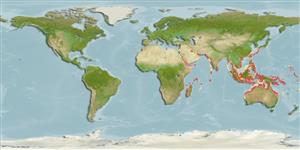Environment: milieu / climate zone / depth range / distribution range
पारिस्थितिकी
समुद्री; स्वच्छ जल, अलवण जल; खारा बेनथोपिलाजिक; ऐम्फिढरोमस (Ref. 51243); गहराई सीमा 0 - 30 m (Ref. 43448). Tropical; 30°N - 26°S
Indo-West Pacific: northern Indian Ocean and the Indo-Australian Archipelago. A lessepsian migrant, now prevalent in the Mediterranean (Ref. 43448).
आकार / वज़न / Age
Maturity: Lm ? range ? - ? cm
Max length : 30.0 cm TL पुल्लिंग / अलिंग; (Ref. 58652)
पृष्ठीय रीढ़ (सम्पूर्ण): 11 - 12; पृष्ठीय सौफट रेज़ (सम्पूर्ण): 9-11; गुदा कांटा 3; ऐनल सौफट रेज़: 8 - 9
Adults inhabit coastal waters, entering brackish estuaries (Ref. 3132) and mangrove areas (Ref. 7300). Also in fresh waters (Ref. 30573). Feed on fishes and invertebrates. Eggs are guarded and fanned by the male parent (Ref. 205).
Life cycle and mating behavior
परिपक्व अवधि | पुनरुत्पत्ति | मछलीऔ का अंडे देना | अंडे | Fecundity | लार्वा
Eggs are guarded and fanned by the male parent (Ref. 205).
Paxton, J.R., D.F. Hoese, G.R. Allen and J.E. Hanley, 1989. Pisces. Petromyzontidae to Carangidae. Zoological Catalogue of Australia, Vol. 7. Australian Government Publishing Service, Canberra, 665 p. (Ref. 7300)
IUCN Red List Status (Ref. 130435)
Threat to humans
Harmless
Human uses
मात्स्यिकी: लघु वाणिज्य
अधिक जानकारी
संदर्भजलीयकृषिजलीयकृषि रूपरेखाखींचआनुवंशिकीElectrophoresesहैरेटिबिलटीबीमारीप्रक्रमणNutrientsMass conversion
साधन
Special reports
Download XML
इंटरनेट स्रोत
Estimates based on models
Preferred temperature (Ref.
123201): 24.8 - 29.3, mean 28.5 °C (based on 3744 cells).
Phylogenetic diversity index (Ref.
82804): PD
50 = 0.6250 [Uniqueness, from 0.5 = low to 2.0 = high].
Bayesian length-weight: a=0.00479 (0.00188 - 0.01218), b=3.09 (2.87 - 3.31), in cm total length, based on LWR estimates for this (Sub)family-body shape (Ref.
93245).
Trophic level (Ref.
69278): 3.4 ±0.47 se; based on food items.
लौटाव (Ref.
120179): माध्यम, न्यूनतम जनसंख्या दुगनी होने का समय 1.4 - 4.4 वर्ष। (Preliminary K or Fecundity.).
Fishing Vulnerability (Ref.
59153): Low vulnerability (20 of 100).
Nutrients (Ref.
124155): Calcium = 224 [135, 392] mg/100g; Iron = 1.08 [0.66, 1.73] mg/100g; Protein = 17.3 [16.5, 18.2] %; Omega3 = 0.163 [0.080, 0.322] g/100g; Selenium = 47.6 [23.2, 101.8] μg/100g; VitaminA = 35.1 [14.5, 82.5] μg/100g; Zinc = 2.22 [1.56, 3.01] mg/100g (wet weight);
